Peter Dueben
WeatherBench 2: A benchmark for the next generation of data-driven global weather models
Aug 29, 2023Abstract:WeatherBench 2 is an update to the global, medium-range (1-14 day) weather forecasting benchmark proposed by Rasp et al. (2020), designed with the aim to accelerate progress in data-driven weather modeling. WeatherBench 2 consists of an open-source evaluation framework, publicly available training, ground truth and baseline data as well as a continuously updated website with the latest metrics and state-of-the-art models: https://sites.research.google/weatherbench. This paper describes the design principles of the evaluation framework and presents results for current state-of-the-art physical and data-driven weather models. The metrics are based on established practices for evaluating weather forecasts at leading operational weather centers. We define a set of headline scores to provide an overview of model performance. In addition, we also discuss caveats in the current evaluation setup and challenges for the future of data-driven weather forecasting.
ENS-10: A Dataset For Post-Processing Ensemble Weather Forecast
Jun 29, 2022
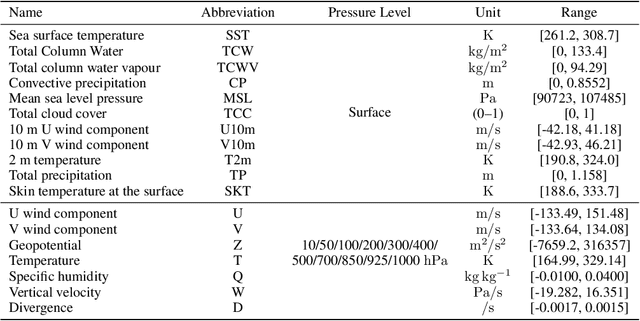

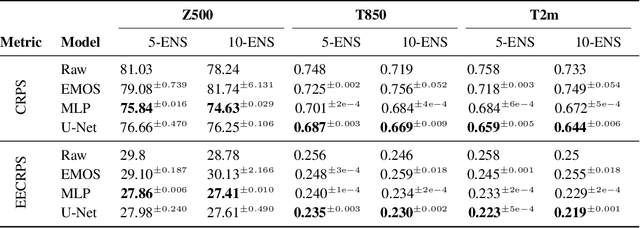
Abstract:Post-processing ensemble prediction systems can improve weather forecasting, especially for extreme event prediction. In recent years, different machine learning models have been developed to improve the quality of the post-processing step. However, these models heavily rely on the data and generating such ensemble members requires multiple runs of numerical weather prediction models, at high computational cost. This paper introduces the ENS-10 dataset, consisting of ten ensemble members spread over 20 years (1998-2017). The ensemble members are generated by perturbing numerical weather simulations to capture the chaotic behavior of the Earth. To represent the three-dimensional state of the atmosphere, ENS-10 provides the most relevant atmospheric variables in 11 distinct pressure levels as well as the surface at 0.5-degree resolution. The dataset targets the prediction correction task at 48-hour lead time, which is essentially improving the forecast quality by removing the biases of the ensemble members. To this end, ENS-10 provides the weather variables for forecast lead times T=0, 24, and 48 hours (two data points per week). We provide a set of baselines for this task on ENS-10 and compare their performance in correcting the prediction of different weather variables. We also assess our baselines for predicting extreme events using our dataset. The ENS-10 dataset is available under the Creative Commons Attribution 4.0 International (CC BY 4.0) licence.
Machine Learning Emulation of Urban Land Surface Processes
Dec 22, 2021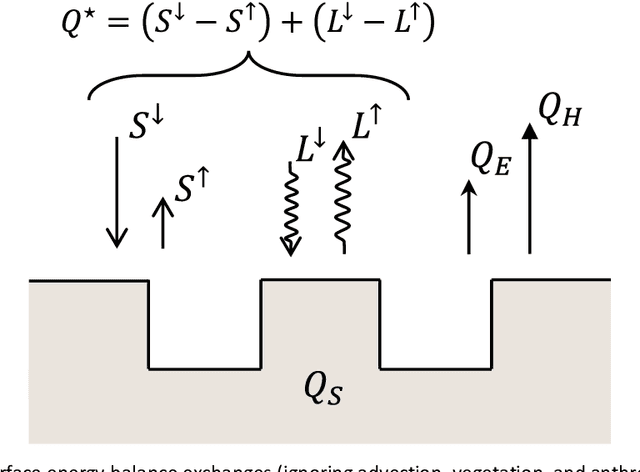
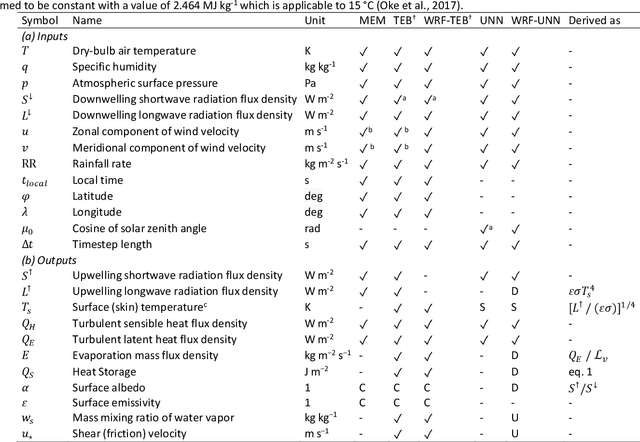
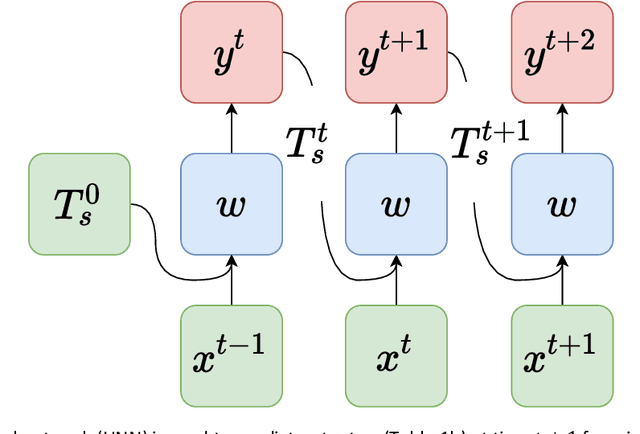
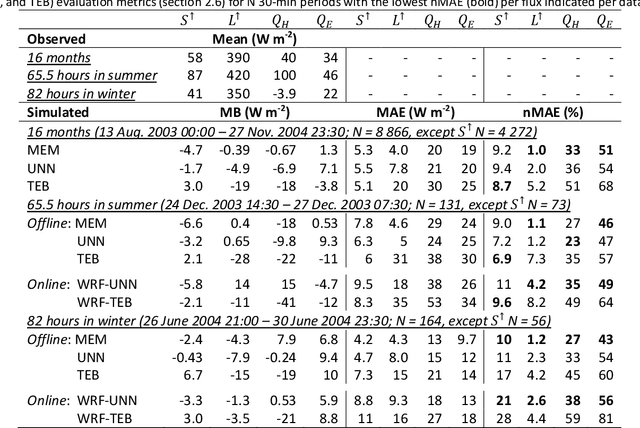
Abstract:Can we improve the modeling of urban land surface processes with machine learning (ML)? A prior comparison of urban land surface models (ULSMs) found that no single model is 'best' at predicting all common surface fluxes. Here, we develop an urban neural network (UNN) trained on the mean predicted fluxes from 22 ULSMs at one site. The UNN emulates the mean output of ULSMs accurately. When compared to a reference ULSM (Town Energy Balance; TEB), the UNN has greater accuracy relative to flux observations, less computational cost, and requires fewer input parameters. When coupled to the Weather Research Forecasting (WRF) model using TensorFlow bindings, WRF-UNN is stable and more accurate than the reference WRF-TEB. Although the application is currently constrained by the training data (1 site), we show a novel approach to improve the modeling of surface fluxes by combining the strengths of several ULSMs into one using ML.
Probabilistic Forecasting with Conditional Generative Networks via Scoring Rule Minimization
Dec 15, 2021



Abstract:Probabilistic forecasting consists of stating a probability distribution for a future outcome based on past observations. In meteorology, ensembles of physics-based numerical models are run to get such distribution. Usually, performance is evaluated with scoring rules, functions of the forecast distribution and the observed outcome. With some scoring rules, calibration and sharpness of the forecast can be assessed at the same time. In deep learning, generative neural networks parametrize distributions on high-dimensional spaces and easily allow sampling by transforming draws from a latent variable. Conditional generative networks additionally constrain the distribution on an input variable. In this manuscript, we perform probabilistic forecasting with conditional generative networks trained to minimize scoring rule values. In contrast to Generative Adversarial Networks (GANs), no discriminator is required and training is stable. We perform experiments on two chaotic models and a global dataset of weather observations; results are satisfactory and better calibrated than what achieved by GANs.
TRU-NET: A Deep Learning Approach to High Resolution Prediction of Rainfall
Aug 20, 2020



Abstract:Climate models (CM) are used to evaluate the impact of climate change on the risk of floods and strong precipitation events. However, these numerical simulators have difficulties representing precipitation events accurately, mainly due to limited spatial resolution when simulating multi-scale dynamics in the atmosphere. To improve the prediction of high resolution precipitation we apply a Deep Learning (DL) approach using an input of CM simulations of the model fields (weather variables) that are more predictable than local precipitation. To this end, we present TRU-NET (Temporal Recurrent U-Net), an encoder-decoder model featuring a novel 2D cross attention mechanism between contiguous convolutional-recurrent layers to effectively model multi-scale spatio-temporal weather processes. We use a conditional-continuous loss function to capture the zero-skewed %extreme event patterns of rainfall. Experiments show that our model consistently attains lower RMSE and MAE scores than a DL model prevalent in short term precipitation prediction and improves upon the rainfall predictions of a state-of-the-art dynamical weather model. Moreover, by evaluating the performance of our model under various, training and testing, data formulation strategies, we show that there is enough data for our deep learning approach to output robust, high-quality results across seasons and varying regions.
Deep Learning for Post-Processing Ensemble Weather Forecasts
May 18, 2020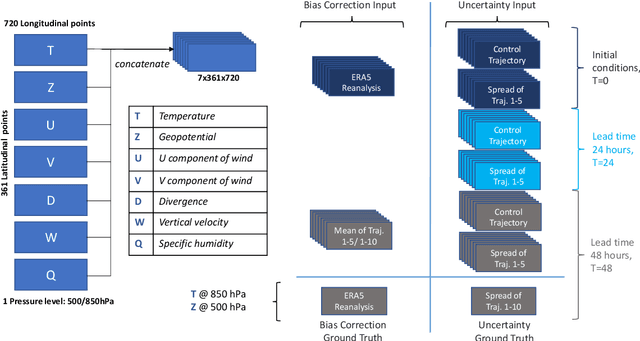
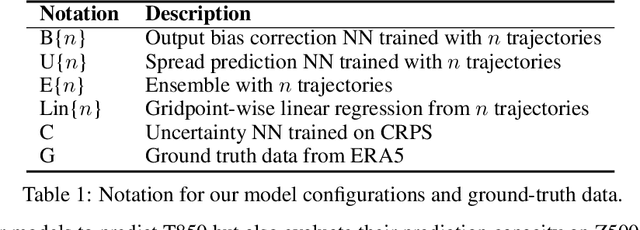
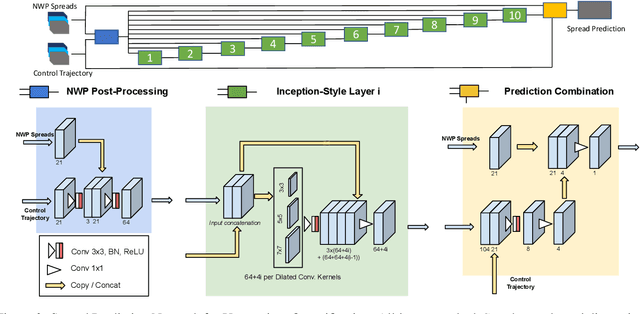

Abstract:Quantifying uncertainty in weather forecasts typically employs ensemble prediction systems, which consist of many perturbed trajectories run in parallel. These systems are associated with a high computational cost and often include statistical post-processing steps to inexpensively improve their raw prediction qualities. We propose a mixed prediction and post-processing model based on a subset of the original trajectories. In the model, we implement methods from deep learning to account for non-linear relationships that are not captured by current numerical models or other post-processing methods. Applied to global data, our mixed models achieve a relative improvement of the ensemble forecast skill of over 13%. We demonstrate that this is especially the case for extreme weather events on selected case studies, where we see an improvement in predictions by up to 26%. In addition, by using only half the trajectories, the computational costs of ensemble prediction systems can potentially be reduced, allowing weather forecasting pipelines to run higher resolution trajectories, and resulting in even more accurate raw ensemble forecasts.
Predicting Weather Uncertainty with Deep Convnets
Dec 04, 2019



Abstract:Modern weather forecast models perform uncertainty quantification using ensemble prediction systems, which collect nonparametric statistics based on multiple perturbed simulations. To provide accurate estimation, dozens of such computationally intensive simulations must be run. We show that deep neural networks can be used on a small set of numerical weather simulations to estimate the spread of a weather forecast, significantly reducing computational cost. To train the system, we both modify the 3D U-Net architecture and explore models that incorporate temporal data. Our models serve as a starting point to improve uncertainty quantification in current real-time weather forecasting systems, which is vital for predicting extreme events.
 Add to Chrome
Add to Chrome Add to Firefox
Add to Firefox Add to Edge
Add to Edge